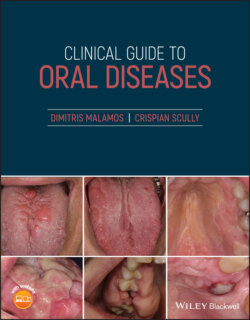Читать книгу Clinical Guide to Oral Diseases - Crispian Scully - Страница 47
4 Malodor
ОглавлениеMalodor, also known as halitosis, is unpleasant bad breath that causes severe patient concern and a negative effect on the patient's life. Halitosis is caused by the release of various volatile gases, either during food breakdown from various bacteria that are normal inhabitants in the patient's mouth, or during expiration of odorous substances which are moved via circulation from the periphery. Halitosis can easily be detected by other people (real) or not (fake). The majority of causes of real halitosis come from disorders inside the mouth (>85%) and the remaining are from nose, sinuses, throat, lungs, stomach, pancreas, and liver. Fake halitosis (halitophobia) is common in patients with severe anxiety, depression, or obsessive compulsive disorder. The basic step in halitosis treatment is the recognition and treatment of its underlying cause (Figure 4.0a and b).
The more common causes of halitosis are listed in Table 4.
Figure 4.0a Halitosis from a patient with advanced oro‐nasal carcinoma.
Figure 4.0b Halitosis from a patient with a neglected mouth.
Table 4 Common and important conditions associated with malodor
| Malodor |
| Physical causesFood or fluid ingredientsOnions/garlicFoodstuffs/additivesSpiceAlcoholFood or fluid lackStarvation or dehydrationHabitsSmokingHeavy drinkingLocal causesRelated with the mouthCariesAcute ulcerative gingivitisPericoronitisChronic periodontitisChronic dental abscessOsteonecrosismyelitisMedicated osteonecrosis (due to bisphosphonates, denosumab, bevacizumab)Dry socketNomaOroantral fistulaSinusitisUlcerations, i.e. pemphigus vulgaris (PV)SialdenitisNeoplasmsRelated with pharynx/esophagusTonsillitisEsophangeal infectionrefluxpouchNeoplasmsSystemic causes Diseases fromliverHepatic failureKidneyRenal failureLungsInfectionsBronchiectasisNeoplasmsGutGastric regurgitationCNSTemporal lobe epilepsyTemporal lobe tumorsDelusionsMetabolismTrimethylaminuriaDrugsAssociated with xerostomiaAntihistaminesDiureticsNarcoticsAntidepressantsDecongestantsAntihypertensiveAntipsychotics |
